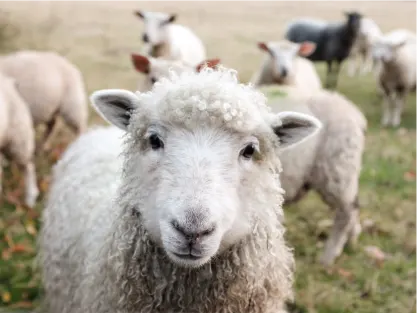Wool is probably the natural product par excellence. It stands for cuddly wool socks, knitted hats and warming jackets. The temperature-regulating properties of the wool for underwear are also used in sportswear. All advantages, which should not be used, or shouldn't they?
Like many products, wool has become a mass commodity. Around 2.2 million tonnes of wool are produced every year in nearly 100 countries. Most of it in Australia, followed by China and New Zealand.
Situation in Switzerland
Swiss wool production is by no means a profitable business. Per shearing, a sheep gives two to three kilograms of wool. For this the owner receives about two francs. But the shearing alone costs five francs per sheep. If you count the time to sort the wool and add the transport or port costs, the bottom line is red. Therefore, about half of the wool is thrown into the garbage or burned. The other half is mainly used as mattress fleeces, building insulation and carpets, since the wool of Swiss sheep is too coarse and therefore unsuitable for clothing. The production of wool is therefore of no importance to Swiss sheep farmers. Much more important is the meat of the animals. 98 percent of the income from the keeping of the herds comes of the meat production.1
Mulesing
Let us turn to the "high-quality" wool from the number 1 producing country, Australia. There, more than 125 million sheep produce more than 20 percent of the world's yield.
There are stocks of thousands of sheep, which makes it virtually impossible to pay attention to an animal or provide medical assistance in case of emergency. Specially for wool production, merinos are bred with very wrinkled skin, so that they grow even more hair. This unnatural excess of wool causes many sheep to collapse during the hot months under the heat and die of heat stroke. In warm regions, the merinos are often attacked by flies, whose hatched larvae eagerly eat the sheep from the inside. In an attempt to prevent this "fly infection", the Australian ranches are undertaking a barbaric intervention on the animals - the "mulesing". For this purpose, the living sheep are thrown on their backs with the application of force and their legs are fixed between metal bars. Then they are sliced - without any painkillers - large pieces of meat from the area around their tails. The aim is to achieve a smooth, scarred surface which no longer provides an attack surface for flies. Ironically, however, these large-area bloody wounds are often attacked by flies even before they can heal.2
Sheep shearing
The workers who do the shearing are usually paid by lot, not by hours. Therefore, they are motivated to work as quickly as possible, without regard to the sheep. Eyewitnesses report horrific scenes that happen repeatetly during the shearing. The sheep are often cut and severely injured.
Lambs
A few weeks after her birth, the lambs' ears are perforated, the tails are cut off, and the male animals are castrated, all without anesthesia. Castration of the male lambs takes place in the second to eighth week of life, either by making a cut and cutting the testicles or cutting off the blood supply with a rubber ring - one of the most painful castration methods existing.
Transport around half the world
When the wool production is declining, the sheep are sold to slaughterhouses all over the world. This leads annually to the cruel life-export of 6.5 million sheep from Australia to the Middle East and to North Africa. In Australia, sheep travel huge distances across land until they reach the collection points from which they are loaded onto ships. Many sheep - stressed, ill or injured by transport - die under the cramped conditions, the diseases and the unfamiliar food or at the collecting points. The surviving sheep are loaded closely to ships. Younger animals or babies born on the road are often trampled to death. The mortality rate on board is up to 10 percent, and for every sheep that dies, there are numerous others who are sick or injured. For example, 14500 sheep died of heat stroke when they were on their way to the Middle East in 2002. Their bodies were simply thrown overboard.3
Cashmere
Cashmere comes from the fine underwear of the cashmere goat, which are bred to millions in China and Mongolia. Animals whose skin has "defects" are usually killed before they are two years old. Experts in this industry assume that farmers kill 50 to 80 percent of their young animals because their skins do not meet the requirements.
Angora
Angora rabbits are kept in tight wire cages at tens of thousands. China dominates the international market for angora wool with over 90 percent. The rabbits spend their lives in cages, the wire mesh often leads to ulcers at the feet. For the shearing the animals are put on a board. The Wollausbeute in male Angora rabbits is compared to that of female only about 75 to 80 per cent. For this reason, the males are killed on many farms immediately after birth.
What can you do?
Wear and buy animal-friendly materials that are - in contrast to wool - even water-repellent. Tencel is breathable, durable and biodegradable. Lyocell (from cellulose) has the same soft feel as Cashmere, and Polartec Wind Pround is moisture-repellent. Further alternatives to wool are also polyester fleece, sisal, bamboo, cotton flannel, viscose, nonwoven, acrylic, hemp and soya silk.
Bernadette Raschle




